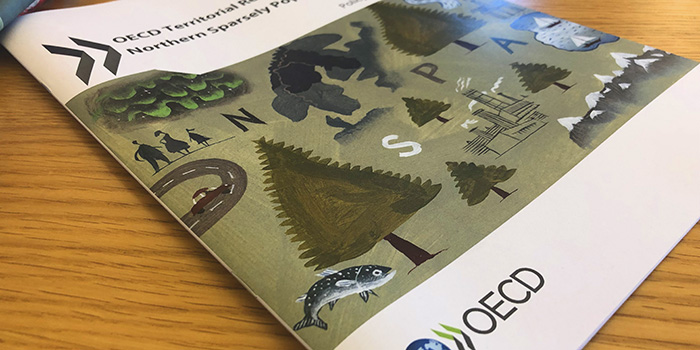OECD report
In 2017, the OECD published a report about opportunities and challenges in the norther sparsely populated areas of Europe. The report finds that North Sweden faces unique challenges that makes the regions vulnerable, such as great distances, a sparse and aging population, a small critical mass, cold climate and a sensitive economy based on natural resources. But it also finds that the economic activity in the regions provide substantial value to the member states and to EU as a whole. The region has excellent potential for an even higher growth if there's more resources put into creating conditions for innovation.

The report, called "OECD Territorial review. Northern Sparsely Populated Areas", was the product of two years of research and joint discussion between the OECD and the NSPA region. It sets policy recommendations at cross-border, national and regional scale to enhance prosperity and well-being across the NSPA. By doing so, the report delivers support for adapted strategies, and support to the regions release their potential. This includes investments in infrastructure, broadband, smart regional specialisation and innovation.
Over the years, the NSPA has identified the collective potential the NSPA-regions have to enhance competition in Europe through mainly two studies: Nordregio’s study ”Strong, specific and promising" - a vision of the future for northern Europe, released in 2009, as well as territorial evaluation –a report – of the NSPA-regions in 2017. The studies shows that the northern regions of europe can contribute with growth beneficial for all of Europe. It also confirms that the regions competition has the potential to rise further if this is done in a way where the regional development collaboration is shaped in a long-term, cohesive, coal oriented and based on the region's comparative advantages.
Parallelly while the work with the NSPA-study was happening, the Swedish government decided to follow up on the national study that OECD completed in 2010. The follow-up study, titled "OECD Territorial Reviews: Sweden 2017", gives and overview on how Sweden has implemented and worked with the recommendations previously given by the OECD. It also contributes with new recommendations for regional development. The Swedish government partially tied the report to NSPA by giving it a special focus on innovation and sustainable rural development. Furthermore, in their study "Regional Outlook 2016" the OECD chose to analyse growth in more sparsely populated areas. Their results showed a great potential for growth despite specific challenges in these areas. The OECD concluded that the geopolitically important North Sweden, highly contributes to Sweden’s and Europe’s continued growth. The region has excellent potential for an even higher growth if there's more resources put into creating the proper conditions for innovation, into transport and digital infrastructure, and more collaboration over the national borders of NSPA.
North Sweden faces unique challenges that makes the regions vulnerable, such as great distances, a sparse and aging population, a small critical mass, cold climate and a cyclically sensitive economy based on natural resources. The studies emphasizes that both rural regions in close proximity to larger cities, as well as remote regions, contributes to the national and european added value in many ways. Among other things, the societies outside the so called densely populated areas contributes with 68% of areas where growth happens in the OECD-countries. The regions of northern Sweden has about 9% of the country's population, and produces circa 9% of Sweden's GDP.
OECD also concluded that the national redistribution of additional costs in the northern sparsely populated areas corresponds to 0,2% of Sweden's GDP. In return the regions produces a substantial amount of Sweden's revenue from direct export, contributes with more than half of the country's electricity production, foremost through hydroelectric production, as well as having large industries within forestry, mining and minerals. This provides work opportunities not only in the region, but in the rest of the country in the form of service productions.
It is within that context the regions vulnerability and need for aid to work with that vulnerability, should be seen. The costs for more active and growth promoting measures in North Sweden, is much less than the socio-economic losses for Sweden and the EU, if such indicators are absent. Efforts to transform challenges into opportunities are made through processing and product development of natural resources, by taking advantage of the regions geography and cold climate, to develop innovative techniques, attractive habitats, a hospitality industry and by developing border-crossing technology.
Read more and read the study in full
